A novel 14-base-pair regulatory element is essential for in vivo expression of murine beta4-galactosyltransferase-I in late pachytene spermatocytes and round spermatids
- PMID: 10409768
- PMCID: PMC84431
- DOI: 10.1128/MCB.19.8.5823
A novel 14-base-pair regulatory element is essential for in vivo expression of murine beta4-galactosyltransferase-I in late pachytene spermatocytes and round spermatids
Abstract
During murine spermatogenesis, beginning in late pachytene spermatocytes, the beta4-galactosyltransferase-I (beta4GalT-I) gene is transcribed from a male germ cell-specific start site. We had shown previously that a 796-bp genomic fragment that flanks the germ cell start site and contains two putative CRE (cyclic AMP-responsive element)-like motifs directs correct male germ cell expression of the beta-galactosidase reporter gene in late pachytene spermatocytes and round spermatids of transgenic mice (N. L. Shaper, A. Harduin-Lepers, and J. H. Shaper, J. Biol. Chem. 269:25165-25171, 1994). We now report that in vivo expression of beta4GalT-I in developing male germ cells requires an essential and previously undescribed 14-bp regulatory element (5'-GCCGGTTTCCTAGA-3') that is distinct from the two CRE-like sequences. This cis element is located 16 bp upstream of the germ cell-specific start site and binds a male germ cell protein that we have termed TASS-1 (transcriptional activator in late pachytene spermatocytes and round spermatids 1). The presence of the Ets signature binding motif 5'-GGAA-3' on the bottom strand of the TASS-1 sequence (underlined sequence) suggests that TASS-1 is a novel member of the Ets family of transcription factors. Additional transgenic analyses established that an 87-bp genomic fragment containing the TASS-1 regulatory element was sufficient for correct germ cell-specific expression of the beta-galactosidase reporter gene. Furthermore, when the TASS-1 motif was mutated by transversion, within the context of the original 796-bp fragment, transgene expression was reduced 12- to 35-fold in vivo.
Figures


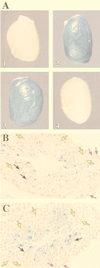
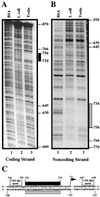
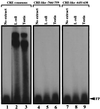
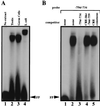
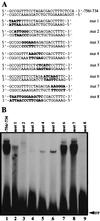


Similar articles
-
Male germ cell expression of murine beta 4-galactosyltransferase. A 796-base pair genomic region, containing two cAMP-responsive element (CRE)-like elements, mediates male germ cell-specific expression in transgenic mice.J Biol Chem. 1994 Oct 7;269(40):25165-71. J Biol Chem. 1994. PMID: 7929205
-
RFX2 is a potential transcriptional regulatory factor for histone H1t and other genes expressed during the meiotic phase of spermatogenesis.Biol Reprod. 2004 Nov;71(5):1551-9. doi: 10.1095/biolreprod.104.032268. Epub 2004 Jun 30. Biol Reprod. 2004. PMID: 15229132
-
The expanding family of CREB/CREM transcription factors that are involved with spermatogenesis.Mol Cell Endocrinol. 2002 Feb 22;187(1-2):115-24. doi: 10.1016/s0303-7207(01)00696-7. Mol Cell Endocrinol. 2002. PMID: 11988318 Review.
-
Murine beta 1,4-galactosyltransferase: round spermatid transcripts are characterized by an extended 5'-untranslated region.Glycobiology. 1992 Aug;2(4):361-8. doi: 10.1093/glycob/2.4.361. Glycobiology. 1992. PMID: 1384819
-
Coupling signalling pathways to transcriptional control: nuclear factors responsive to cAMP.Recent Prog Horm Res. 1997;52:121-39; discussion 139-40. Recent Prog Horm Res. 1997. PMID: 9238850 Review.
Cited by
-
Lessons from knockout and transgenic mice for infertility in men.J Endocrinol Invest. 2000 Oct;23(9):584-91. doi: 10.1007/BF03343780. J Endocrinol Invest. 2000. PMID: 11079453 Review.
-
Functional cooperation between CREM and GCNF directs gene expression in haploid male germ cells.Nucleic Acids Res. 2010 Apr;38(7):2268-78. doi: 10.1093/nar/gkp1220. Epub 2010 Jan 13. Nucleic Acids Res. 2010. PMID: 20071744 Free PMC article.
-
Regulation of murine lactate dehydrogenase C (Ldhc) gene expression.Biol Reprod. 2008 Mar;78(3):455-61. doi: 10.1095/biolreprod.107.064964. Epub 2007 Dec 5. Biol Reprod. 2008. PMID: 18057313 Free PMC article.
-
Basic helix-loop-helix transcription factor Tcfl5 interacts with the Calmegin gene promoter in mouse spermatogenesis.Nucleic Acids Res. 2004 Dec 7;32(21):6425-36. doi: 10.1093/nar/gkh979. Print 2004. Nucleic Acids Res. 2004. PMID: 15585666 Free PMC article.
-
A-MYB (MYBL1) stimulates murine testis-specific Ldhc expression via the cAMP-responsive element (CRE) site.Biol Reprod. 2012 Feb 9;86(2):30. doi: 10.1095/biolreprod.111.095661. Print 2012 Feb. Biol Reprod. 2012. PMID: 21998171 Free PMC article.
References
-
- Beyer T A, Hill R L. Glycosylation pathways in the biosynthesis of nonreducing terminal sequences in oligosaccharides of glycoproteins. III. New York, N.Y: Academic Press, Inc.; 1982. pp. 25–45.
-
- Blendy J A, Kaestner K H, Weinbauer G F, Nieschlag E, Schutz G. Severe impairment of spermatogenesis in mice lacking the CREM gene. Nature. 1996;380:162–165. - PubMed
-
- Brodbeck U, Denton W L, Tanahashi N, Ebner K E. The isolation and identification of the B protein of lactose synthetase as α-lactalbumin. J Biol Chem. 1967;242:1391–1397. - PubMed
-
- Brown T A, McKnight S L. Specificities of protein-protein and protein-DNA interaction of GABPα and two newly defined ets-related proteins. Genes Dev. 1992;6:2502–2512. - PubMed
Publication types
MeSH terms
Substances
Grants and funding
LinkOut - more resources
Full Text Sources
Molecular Biology Databases
